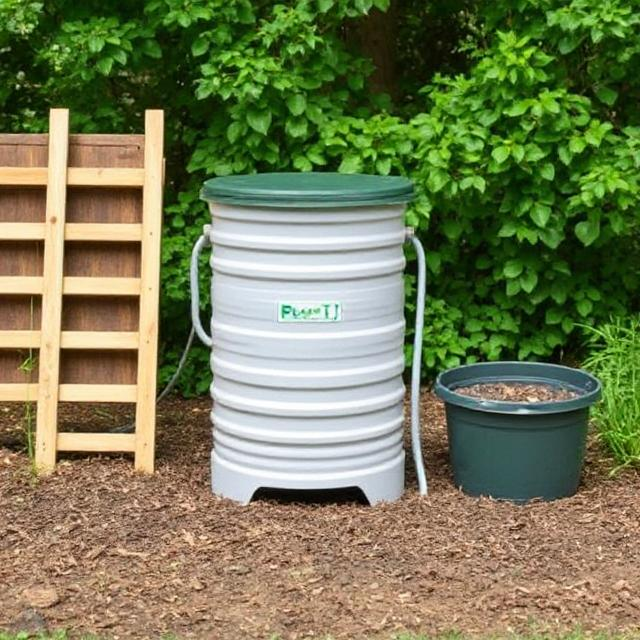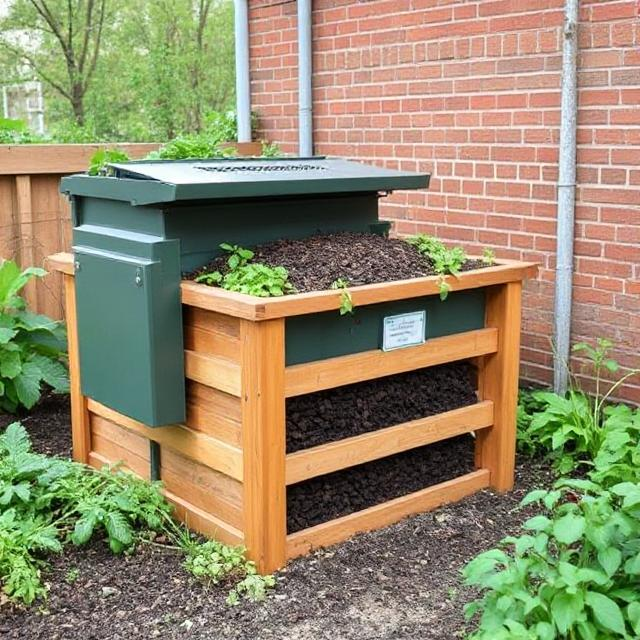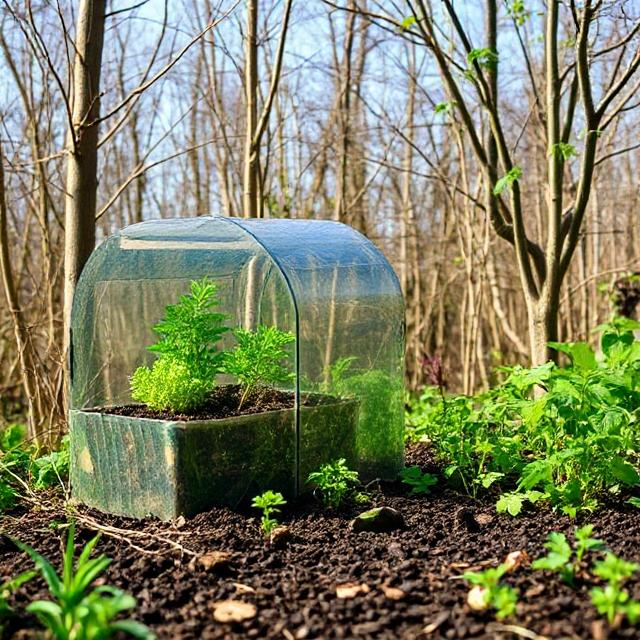
Smart Composting Systems are advanced composting solutions that utilize technology to streamline the composting process. These systems incorporate sensors, automated features, and mobile applications to manage organic waste efficiently, making composting accessible for urban and rural households alike. The integration of technology not only simplifies the composting process but also enhances the effectiveness of waste decomposition, leading to higher quality compost.
Importance of Composting
Composting is vital for several reasons:
Waste Reduction: Organic waste constitutes about 30% of total municipal solid waste. Composting diverts this waste from landfills, reducing the burden on waste management systems and minimizing methane emissions, a potent greenhouse gas. By composting, households can significantly decrease their environmental footprint and contribute to a more sustainable waste management system.
Soil Enrichment: Compost improves soil structure, enhances nutrient content, and increases water retention. This leads to healthier plants and reduced need for chemical fertilizers, promoting sustainable agriculture. The nutrients in compost, such as nitrogen, phosphorus, and potassium, are essential for plant growth and can help restore depleted soils.
Resource Conservation: By recycling nutrients back into the soil, composting contributes to a circular economy, where waste is minimized and resources are reused. This not only conserves natural resources but also reduces the need for synthetic fertilizers, which can have harmful environmental impacts.
Key Features of Smart Composting Systems

Automated Aeration
Mechanism: Smart composters are equipped with fans or blowers that circulate air within the compost bin. This aeration is crucial for aerobic bacteria, which thrive in oxygen-rich environments and break down organic matter more efficiently than anaerobic bacteria, which can produce foul odors. Proper aeration helps maintain the optimal balance of carbon and nitrogen, essential for effective composting.
User Control: Users can customize aeration settings based on the materials being composted. For example, a higher aeration rate may be needed for wet materials to prevent anaerobic conditions, while drier materials may require less aeration. Advanced systems may automatically adjust aeration based on real-time data, ensuring optimal conditions for decomposition.
Temperature Control
Heating Elements: Some smart composters feature built-in heating elements that help maintain optimal temperatures for microbial activity, typically between 130°F and 160°F. This range accelerates decomposition and kills pathogens and weed seeds. Maintaining the right temperature is essential for the composting process, as it promotes the growth of thermophilic bacteria that speed up the breakdown of organic materials.
Monitoring: Advanced systems allow users to monitor internal temperatures via a mobile app, providing insights into the composting process. Alerts can notify users if temperatures fall outside the optimal range, prompting them to adjust conditions. This feature ensures that the composting process remains efficient and effective.
Mobile App Integration
User Interface: The mobile app is designed to be intuitive, featuring dashboards that display real-time data on compost status, including temperature, moisture levels, and the estimated time until the compost is ready. Users can easily access this information at any time, making it convenient to manage their composting efforts.
Notifications: Users receive alerts for necessary actions, such as adding water or turning the compost. The app may also provide reminders for maintenance tasks, like replacing filters or cleaning components. This proactive approach helps users stay engaged with the composting process and ensures that the composting system operates optimally.
Odor Control Mechanisms
Carbon Filters: Many smart composters include replaceable carbon filters that absorb and neutralize odors, making them suitable for indoor use. These filters can be easily replaced to maintain effectiveness. Proper odor control is crucial for encouraging users to adopt composting practices, especially in urban settings where space is limited.
Sealed Design: A well-sealed design prevents odors from escaping and keeps pests out. This is particularly beneficial for urban users who may have limited outdoor space for composting. The sealed design also helps maintain moisture levels within the compost bin, further enhancing the decomposition process.
User Friendly Design
Compact Size: Smart composters are often designed to fit in small spaces, making them ideal for apartments, condos, and small homes. Some models can be placed on countertops or balconies, allowing users to compost conveniently without requiring large outdoor areas.
Accessibility: Features such as easy-access lids, removable compost bins, and clear instructions simplify the process of adding waste and retrieving finished compost. User-friendly designs encourage more people to participate in composting, promoting sustainable practices within communities.
Benefits of Smart Composting Systems

Environmental Impact
Waste Reduction: Households can divert 30-50% of their waste to composting. For example, a family producing 10 pounds of waste daily could compost 3-5 pounds, significantly reducing landfill contributions. This reduction in waste not only helps the environment but also reduces the costs associated with waste disposal.
Soil Health: Compost enriches soil with essential nutrients, promotes microbial diversity, and improves soil structure, leading to healthier ecosystems. This is crucial for sustainable agriculture and gardening, as healthy soil is the foundation for productive plant growth. Compost also enhances soil’s ability to retain moisture, reducing the need for irrigation.
Economic Advantages
Cost Savings: Users can save on waste disposal fees and reduce the need for chemical fertilizers, which can be expensive. For instance, using homemade compost can reduce fertilizer costs by up to 50%. Additionally, composting can lower the frequency of garbage collection, further reducing expenses.
Increased Property Value: Sustainable practices can enhance property appeal. Homes with well-maintained gardens that utilize compost may attract environmentally conscious buyers, potentially increasing resale value. Properties with established composting systems can be marketed as eco-friendly, appealing to a growing market segment interested in sustainability.
Educational Opportunities
Family Involvement: Smart composting systems provide a hands-on way for families to learn about sustainability. Engaging children in the composting process fosters a sense of responsibility towards the environment. Parents can teach kids about the importance of reducing waste and the benefits of composting, instilling lifelong habits.
Community Engagement: Users can participate in local composting initiatives, sharing knowledge and resources with neighbors. Community workshops can enhance awareness and encourage more people to adopt composting practices. By working together, communities can create a culture of sustainability that benefits everyone.
Potential Challenges

Initial Investment
Cost Barrier: The upfront investment for smart composting systems can range from $200 to $1,000, depending on features and capacity. This cost may deter some users, especially those on a tight budget. To address this barrier, manufacturers could offer financing options or promote the long-term savings associated with composting.
Value Perception: Users may need education on the long-term benefits and cost savings associated with composting to justify the initial expense. Demonstrating successful case studies can help alleviate concerns. Providing clear information on potential savings and environmental benefits can encourage more people to invest in smart composting systems.
Technology Reliance
Technical Issues: Dependence on technology means that malfunctions can disrupt the composting process. Users may need access to customer support for troubleshooting and repairs. Offering comprehensive customer service, including online resources and responsive support teams, can help users navigate technical challenges.
User Accessibility: Not all users may have access to smartphones or the internet, limiting the effectiveness of app-based systems. Manufacturers could consider alternative methods for monitoring and control, such as physical displays or manual controls, to accommodate a broader audience.
Learning Curve
Adaptation: Users may require time to become familiar with the technology and processes involved in using smart composting systems effectively. Offering tutorials and guides can help ease this transition. Manufacturers can create instructional videos or host workshops to educate users on best practices.
Material Knowledge: Understanding which materials are suitable for composting is essential for success. Users should be educated on compostable items (e.g., fruit and vegetable scraps) versus non-compostable items (e.g., meat, dairy, and oily foods). Providing clear guidelines and resources can help users make informed decisions about what to compost.
User Testimonials
Urban Residents
Convenience: Urban users often highlight the convenience of smart composting systems, noting how easy it is to compost kitchen scraps without the mess associated with traditional methods. Many appreciate the ability to compost in small spaces, allowing them to participate in sustainable practices despite living in dense environments.
Space Saving: Users report that compact designs fit well in their kitchens or balconies, making composting feasible even in limited spaces. The aesthetic appeal of some smart composters also encourages users to keep them visible and integrated into their home environments.
Families
Educational Value: Parents appreciate the educational benefits, stating that involving children in the composting process fosters a sense of responsibility towards the environment. Kids can learn about decomposition and the importance of reducing waste, making composting a valuable family activity.
Fun Activities: Families can turn composting into a fun activity, such as tracking decomposition progress or creating a composting journal to document their experiences. This engagement promotes discussions about sustainability and environmental stewardship.
Gardening Enthusiasts
Quality of Compost: Gardeners frequently praise the high quality of compost produced, which leads to healthier plants and improved garden yields. Many report that using compost reduces the need for chemical fertilizers, resulting in more sustainable gardening practices.
Sustainable Practices: Users often align their composting efforts with broader sustainable gardening practices, such as permaculture and organic gardening, further enhancing their environmental impact. Composting becomes a key component of a holistic approach to gardening that prioritizes ecological balance.
Future Trends in Smart Composting

Integration with Smart Home Technologies
Home Automation: Future systems may integrate with other smart home devices, allowing users to manage waste and composting alongside other home management tasks. For example, composters could communicate with smart irrigation systems to optimize garden watering based on compost availability.
Voice Activation: Integration with voice-activated assistants (e.g., Amazon Alexa, Google Assistant) could allow users to control composting features hands-free, enhancing convenience. Users could ask their devices for compost status updates or to adjust settings without needing to access their phones.
Enhanced AI Features
Data Driven Optimization: Future innovations may include AI that analyzes composting data to optimize conditions automatically, ensuring the best composting results without user intervention. This could lead to faster compost production and higher quality end products.
Predictive Analytics: AI could provide insights into when compost will be ready based on user input and environmental conditions, helping users plan their gardening activities more effectively. Predictive analytics could also suggest optimal times for adding materials or turning the compost.
Community Composting Programs
Collaboration: Neighborhoods may establish community composting initiatives that utilize smart composting systems, promoting collective sustainability efforts. These programs can share resources and knowledge, increasing participation and fostering a sense of community.
Shared Resources: Communities could pool resources to purchase smart composters, making them more affordable and accessible to residents. Workshops and community events can educate members about composting benefits and techniques, encouraging widespread adoption.
Sustainable Materials
Eco-Friendly Manufacturing: Manufacturers may focus on producing smart composters from recycled or sustainable materials, appealing to environmentally conscious consumers. This approach reduces the carbon footprint associated with production and aligns with consumer preferences for eco-friendly products.
Biodegradable Components: Future designs may incorporate biodegradable components, further reducing the environmental footprint of composting systems. This innovation could enhance the overall sustainability of composting solutions and attract a broader audience.
Conclusion
Smart Composting Systems represent a transformative approach to waste management. By integrating technology with eco-friendly practices, these systems make composting accessible and efficient for everyone. As awareness of sustainability grows, smart composting solutions are poised to become essential tools in households across the USA, contributing to a greener healthier planet.
Final Thoughts
The shift towards smart composting is not just about convenience; it represents a broader movement towards sustainable living. As more individuals and families adopt these systems, the cumulative impact on waste reduction and soil health can be significant. By embracing technology and sustainability, we can create a more resilient and environmentally friendly future.



Коммерческий автотранспорт в лизинг: почему это выгоднее кредита
лизинг грузовых авто https://lizing-avto0.ru/gruzovye-avtomobili/ .